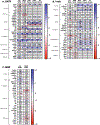Beyond the binary: Characterizing the relationships between sex and neuropeptide receptor binding density measures in the rat brain
- PMID: 38128247
- PMCID: PMC11624905
- DOI: 10.1016/j.yhbeh.2023.105471
Beyond the binary: Characterizing the relationships between sex and neuropeptide receptor binding density measures in the rat brain
Abstract
Sex differences exist in numerous parameters of the brain. Yet, sex-related factors are part of a large set of variables that interact to affect many aspects of brain structure and function. This raises questions regarding how to interpret findings of sex differences at the level of single brain measures and the brain as a whole. In the present study, we reanalyzed two datasets consisting of measures of oxytocin, vasopressin V1a, and mu opioid receptor binding densities in multiple brain regions in rats. At the level of single brain measures, we found that sex differences were rarely dimorphic and were largely persistent across estrous stage and parental status but not across age or context. At the level of aggregates of brain measures showing sex differences, we tested whether individual brains are 'mosaics' of female-typical and male-typical measures or are internally consistent, having either only female-typical or only male-typical measures. We found mosaicism for measures showing overlap between females and males. Mosaicism was higher a) with a larger number of measures, b) with smaller effect sizes of the sex difference in these measures, and c) in rats with more diverse life experiences. Together, these results highlight the limitations of the binary framework for interpreting sex effects on the brain and suggest two complementary pathways to studying the contribution of sex to brain function: (1) focusing on measures showing dimorphic and persistent sex differences and (2) exploring the relations between specific brain mosaics and specific endpoints.
Keywords: Age; Estrous cycle; Juvenile; Mosaics; Opioids; Oxytocin; Primiparous; Sex differences; Sex similarities; Vasopressin.
Copyright © 2023. Published by Elsevier Inc.
Conflict of interest statement
Declaration of competing interest None.
Figures




References
-
- Arsenijevic Y, Dreifuss JJ, Vallet P, Marguerat A, Tribollet E, 1995. Nov 6. Reduced binding of oxytocin in the rat brain during aging. Brain Res. 698 (1–2), 275–279. - PubMed
Publication types
MeSH terms
Substances
Grants and funding
LinkOut - more resources
Full Text Sources
Research Materials

